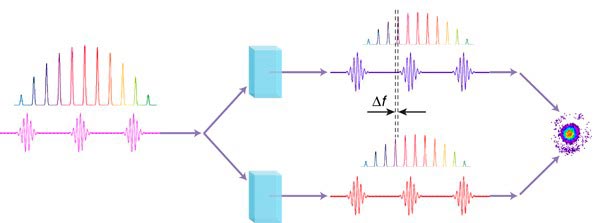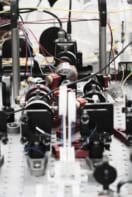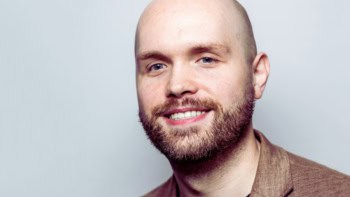
Physicists in the US have used an optical “frequency comb” to reliably entangle a pair of atomic qubits. The breakthrough bodes well for practicable quantum computing because it allows for simpler manipulation of quantum states than in previous systems.
Quantum computing exploits the innate ambiguities of quantum physics to process certain calculations, such as searching or factorizing, much faster than any of today’s computers. Whereas conventional bits of information can take only the values 0 or 1, a quantum computer’s “qubits” exist in a mixed-up superposition of both. This uncertainty allows any number of qubits, N, to be lumped together – or “entangled”, in quantum speak – to represent a huge 2N values, and then processed in parallel. Or, to put it another way, a quantum computer with just 10 entangled qubits could perform 1024 calculations at once.
Entangling isn’t easy, however. Achieving it with atomic-ion qubits, for example, requires two in-phase laser beams that have a frequency separation exactly matching that of the ions’ spin states. In the past, physicists have made such beams from a single modulated laser, or from two lasers locked to a common source, but in either case the lasers must be very powerful to control the spin states with a reasonable speed. And because the spin transitions often lie in the ultraviolet, the lasing frequencies have to be up-shifted with optical systems that are often inefficient.
Nobel inspiration
Now, Chris Monroe and colleagues from the University of Maryland have shown that entanglement can be made more straightforward by using an optical frequency comb. These devices use interference effects on a single laser to create a series of pulses, equally spaced in frequency like the teeth of a comb, an invention that won Theodor W Hänsch and John L Hall the 2005 Nobel Prize for Physics.
Because all the pulses come from the same laser cavity, they are automatically in phase, and frequencies can be altered simply by altering the length of the cavity. This can also be achieved by adding devices known as acousto-optic modulators. Monroe’s group used the beams from a frequency comb to control and entangle two qubits made of ytterbium ions.
“What this paper demonstrates is using the frequency comb itself as thousands of pairs of lasers,” says David Hanneke, a quantum-optics researcher at the National Institute of Standards and Technology in Boulder, Colorado. “This fast laser-pulse method could prove useful in many systems with large qubit splittings, and the high power available in pulsed lasers could give an advantage even in those systems that currently use conventional frequency modulators.”
This research is published in Physical Review Letters.


